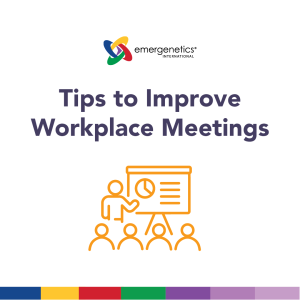
I would venture to guess that every person in the working world has asked themselves our headline question at least once in their lives, and likely more than that. You may also have replaced the word email with chat message, recorded video, text alert or any other medium outside of a live, face-to-face experience.
Meetings certainly have a place and can be valuable avenues to discuss, communicate or share information. And they are not the only way to do so. To maximize the time you, your colleagues and teams are spending working, I’ll explore some of the contributing factors that can help you determine whether it makes sense to gather as well as provide some tips (inspired by the Emergenetics® Attributes) that will allow anyone to run a more effective meeting.
To Meet or Not to Meet? That Is the Question
Before you schedule time for a face-to-face, take a few moments to reflect on the reasoning behind why you want to bring people together. Spending a little more time up front to understand the purpose and intent of the gathering will allow you to better assess the right medium for communication.
Some common reasons that may encourage you to schedule a meeting include:
- Raising complex topics that may require nuanced discussion and raise interrelated questions
- Solving problems that would benefit from multiple perspectives
- Planning interdependent work that can be more efficiently organized
- Sharing big, new ideas that benefit from a spoken narrative or interactivity
- Enhancing team building or reducing workplace disconnect
- Facilitating collaborative exercises or activities that are best accomplished with live discussion
- Introducing major shifts to the way people are working or the business’ direction
- Brainstorming on a topic that would benefit from building on the ideas of others
- Sharing announcements or information that all relevant parties should hear at the same time
It is also worth considering some of the less-than-ideal reasons to call for a gathering to make sure you are using others’ working hours wisely. Those motivations may include:
- Promoting a personal preference for live discussion
- Maintaining an individual or organizational habit to default to meetings
- Assuming that face-to-face is the only way to effectively collaborate
- Acting as a ‘sage on the stage’ without an intent to welcome questions or truly engage others
While this listing of reasons to host or not host a meeting is certainly not exhaustive, I hope it can give you some perspective to determine when it’s wise to schedule a face-to-face and when it may be best to consider another medium.
7 Tips to Make Your Meetings Count
If after this reflection, you have determined that having a live discussion is a positive next step, it’s time to prepare to make sure that all invitees are getting value out of your time together by asking seven important questions.
1) What’s the objective?
Explaining the purpose of a meeting when scheduling it will both engage the Analytical Attribute as well as allow all invitees to understand your intention. This understanding promotes productivity by creating space for informed preparation and aligning the group around a common purpose.
2) What’s on the agenda?
Along with the goal, be mindful to share a plan for the gathering in advance. Having insights into the agenda will engage the Structural Attribute and set clear expectations for participants. Be sure to also inform your invitees if any agenda items require pre-work.
3) Who needs to be here?
Before inviting individuals, carefully consider who needs to be present. While some contributors may not have an active role, clearly articulating why you believe they should be there can ensure you have the right attendees or allow staff to identify whether a different teammate should be included in their place.
4) How does this topic align with big picture needs?
While some gatherings will be tactical in nature, it is still important to make connections with the bigger picture. In doing so, you can honor those with a Conceptual preference while also reinforcing alignment between the topic at hand and the team’s or organization’s aims.
5) What space will you provide to internal and external processors?
Some participants are likely to feel comfortable processing information out loud right as they are hearing it, while others may prefer to gather their thoughts and not be put on the spot. To support people across the Expressiveness spectrum, share relevant information in advance so that those who wish to prepare their thoughts in advance can do so.
6) How will discussion and debate be managed?
Depending on the makeup of your group, you may have some attendees who assert their opinions as direct, driving statements, and others who may do so by asking questions. These styles can sometimes result in unproductive conflict if conversation is not carefully managed. Be ready to facilitate using a second-third Assertive style by setting ground rules for discussion as well as inviting questions and alternative perspectives.
7) What is the threshold for deviation?
Some meetings will be structured to report out on information or share an announcement, while others may be open brainstorms, where you are actively soliciting differing ideas. Still more will be somewhere in between. To support the Flexibility preferences of participants, be up front about how much room there is to introduce alternatives and where you will need to stay the course on what has already been decided upon.
Considering each of the questions above will allow you to better structure your gathering in a way that all Thinking and Behavioral Attributes can be satisfied. When individuals feel like their preferences are honored, it will encourage them to feel more engaged and see the value in their time spent together. Taking a holistic approach will also turn you in a meeting maven by ensuring you are making the most of the time you have with your colleagues.
For more tips to inspire your meeting management, I invite you to explore our recent flipbook on LinkedIn.
Learn how Emergenetics can create a more productive, engaging employee experience. Fill out the form below to speak with one of our team members today!
 Print This Post
Print This Post

